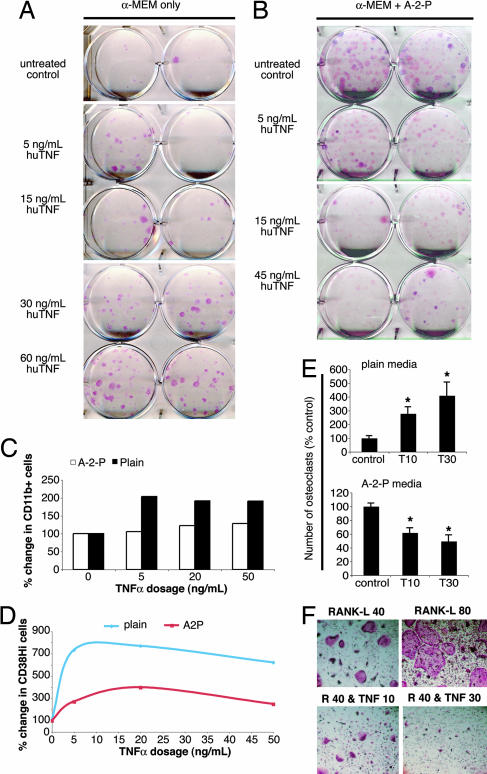Fig. 3.
Ascorbic acid reverses the actions of TNFα on bone metabolism. A and B examine the role of ascorbic acid in modulating TNFα action on osteoblast formation. (A) TNFα dose-dependently increases CFU-F colony formation from total bone marrow in the absence of the ascorbic acid derivative ascorbate-2-phosphate. (B) In the presence of ascorbate-2-phosphate, TNFα dose-dependently decreases CFU-F colony formation from total bone marrow. C and D examine the role of ascorbic acid in modulating TNFα action on osteoclast precursor expansion and osteoclast formation. (C) Treatment of total bone marrow with TNFα leads to an expansion in the number of CD11b+ cells, as assessed by flow cytometry; this effect is blunted in media containing ascorbate-2-phosphate (A-2-P). The y axis denotes the percentage of change in the percentage of all bone marrow cells that were CD11b+. (D) Blunting of the effect of TNFα on the number of cells displaying CD38, a marker of TNFα action on murine macrophages. Total bone marrow from C57BL mice was plated in media either with ascorbate-2-phosphate (A-2-P) or without it in the presence of various doses of TNFα (0–50 ng/ml). After washing to remove nonadherent cells, EDTA was used to lift the adherent cells; these cells were stained with antibodies to CD11b and CD38 after which 30,000 cells were analyzed by flow cytometry. The frequency of CD38+ cells was calculated and plotted as a percentage change from the non-TNFα-treated group. (E) The effects of TNFα on increasing osteoclast formation (Upper) are reversed in the presence of ascorbate-2-phosphate, such that TNFα decreases RANK-L-induced osteoclast formation (Lower). P = 0.02 for 10 ng/ml TNFα and 0.03 for 30 ng/ml in Upper; P = 0.008 for 10 ng/ml and 0.007 for 30 ng/ml in Lower. (F) The appearance of osteoclasts formed in ascorbate-2-phosphate- (A-2-P)-containing medium. Murine bone marrow was flushed and plated with M-CSF (5 ng/ml) for 24 h. Nonadherent cells were used for purification on a Ficoll column. The interface layer was then plated at 3 × 104 cells per well in media containing A-2-P or in media without A-2-P (data not shown). M-CSF (30 ng/ml) was added with RANK-L at 80 ng/ml (Upper Right) or 40 ng/ml (Upper Left and Lower). To some wells, murine TNFα was added at 10 ng/ml (Lower Left) or 30 ng/ml (Lower Right). After 5 days of culture, the cells were fixed and stained for tartrate-resistant acid phosphatase (TRAP).

